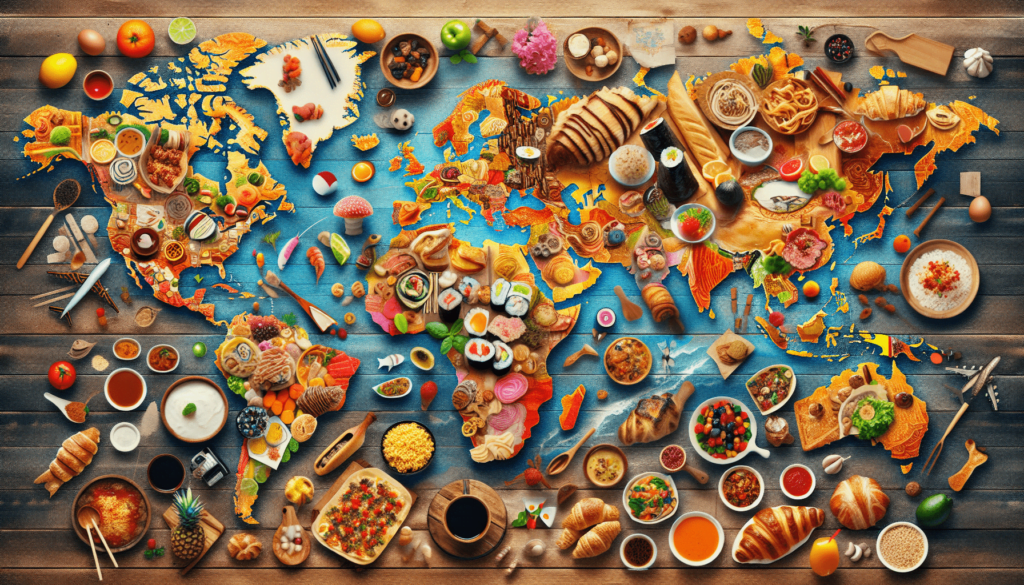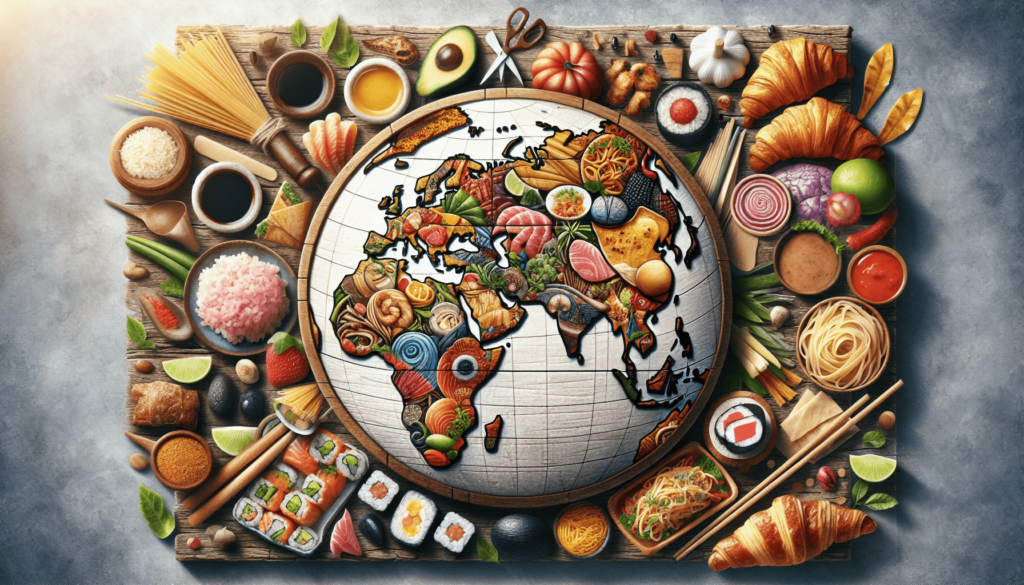Welcome to “Taste Bud Travels: A Global Gastronomic Expedition,” where your palate is your passport to an adventure that spans continents and cultures. In this culinary journey, you’ll embark on a delightful exploration of the world’s most iconic and exotic flavors, from the spicy street foods of Southeast Asia to the hearty comfort dishes of Europe. Not only will you discover the historical roots that have shaped these diverse cuisines, but you’ll also delve into current trends that are redefining our global food landscape.
With vivid descriptions and detailed insights, this article will guide you through the intricate tapestry of global gastronomy, offering rich examples and balanced perspectives to deepen your understanding and appreciation. So, prepare yourself for a mouthwatering expedition that promises to tantalize your taste buds and broaden your culinary horizons. Have you ever wondered what it’s like to embark on a gastronomic journey around the globe, tasting the eclectic flavors and culinary masterpieces that different cultures have to offer?
Table of Contents
Overview
Embarking on a global gastronomic expedition is more than just satisfying your taste buds; it’s a thrilling adventure that takes you through various cultures and traditions. The culinary world is an expansive, vibrant realm that reflects the diversity and creativity of human civilization. By exploring global cuisine, you not only taste different foods but also delve into the stories, histories, and emotions that these dishes bring to the table.
Thesis Statement
“Taste Bud Travels: A Global Gastronomic Expedition” aims to take you on a culinary journey around the world, revealing the historical context, current trends, key concepts, and the wide-ranging impacts of diverse global cuisines. This exploration will help you appreciate the interconnectedness of food cultures and how they contribute to our shared human experience.
Historical Context
Understanding the culinary traditions of different countries often begins with a look at their historical backgrounds. Food has always been intertwined with the social, economic, and political threads of history. Take, for example, the Mediterranean diet. It is not just a modern fad but a culmination of centuries of trade, conquests, and cultural exchange. The ancient spice routes and Silk Road didn’t just transport goods but also flavors, techniques, and culinary philosophies.
Culinary practices evolved through necessity, adaptation, and innovation, influenced by factors such as climate, geography, and available resources. From the fermentation practices of ancient China to Greece’s olive oil and Italy’s pasta, each culinary tradition has roots that dig deep into the soil of history.

Current Trends
In the modern era, food trends evolve rapidly. Globalization has made it easier to experience international cuisines without leaving your hometown. But the current trend extends beyond just eating food from different places. It integrates elements like farm-to-table dining, sustainability, and the fusion of culinary traditions.
Farm-to-Table
The farm-to-table movement emphasizes the importance of eating locally sourced produce, which not only supports local farmers but also ensures that the food is fresh and environmentally sustainable. This trend reflects a growing awareness about health, nutrition, and the environmental impact of our food choices.
Culinary Fusion
Imagine savoring a sushi burrito or a kimchi taco. Fusion cuisine is all about bringing together elements from different culinary traditions to create something innovative and delicious. These hybrid dishes are gaining popularity because they offer a new twist on traditional recipes, making them exciting and adventurous.
Key Concepts and Definitions
Before diving deeper, let’s clarify some key terms that will frequently arise:
- Cuisine: A style or method of cooking, especially as characteristic of a particular country, region, or establishment.
- Gastronomy: The practice or art of choosing, cooking, and eating good food.
- Fusion Cuisine: A culinary style that integrates elements from different food traditions.
- Farm-to-Table: A movement that emphasizes sourcing ingredients locally, ensuring that they travel a short distance from the farm to the table.

Detailed Exploration
Regional Varieties: Asia
Asia is a treasure trove of culinary wonders. Each country in Asia has a rich culinary heritage that reflects its unique culture and history. Whether you are delighting in the intricate flavors of Japanese cuisine or the fiery spices of Indian dishes, there’s always something new to discover.
Japanese Cuisine
In Japan, food is not merely sustenance; it is an art form. From sushi to ramen, Japanese cuisine balances flavors and aesthetics in a way that few other cuisines do. Sushi, for example, showcases the country’s rich seafood tradition, while ramen, with its umami-laden broth and flavorful toppings, is a comfort food that has gained international acclaim.
Indian Cuisine
On the other hand, Indian cuisine is a vibrant tapestry of flavors and techniques. The use of spices like turmeric, cumin, and coriander creates complex flavors that dance on your palate. Indian food also offers a vast array of vegetarian and vegan options, reflecting the country’s diverse cultural and religious landscape.
Regional Varieties: Europe
Europe offers a wide range of culinary experiences, from the hearty dishes of Eastern Europe to the refined tastes of French and Italian cuisine.
French Cuisine
France is often considered the epicenter of culinary art. French cuisine is known for its rich sauces, delicate pastries, and an extensive wine culture. The tradition of haute cuisine, which emphasizes meticulous preparation and presentation, has influenced chefs worldwide. Dishes like coq au vin and escargot exemplify the French dedication to culinary excellence.
Italian Cuisine
Italy, on the other hand, offers comfort food that has universal appeal. With its focus on fresh, high-quality ingredients, Italian cuisine celebrates simplicity and flavor. Whether it’s a classic margherita pizza or a hearty plate of pasta carbonara, Italian food delights in its straightforward, yet deeply satisfying flavors.
Regional Varieties: Americas
The Americas provide a diverse culinary landscape, influenced by indigenous traditions and waves of immigration.
Mexican Cuisine
Mexican cuisine is a flavorful and aromatic journey, featuring ingredients like corn, beans, chilies, and avocados. Dishes like tacos, enchiladas, and tamales are not only delicious but also steeped in the history and culture of Mexico. The use of spices and herbs, along with techniques like grilling and slow-cooking, creates food that is both vibrant and comforting.
American Southern Cuisine
In the United States, southern cuisine holds a special place. With its roots in African, Native American, and European culinary traditions, southern food is rich, comforting, and steeped in history. Dishes like fried chicken, cornbread, and collard greens reflect a culinary tradition that values hearty, flavorful food.
Example: Sushi’s Global Journey
Let’s examine sushi as a case study to understand how a traditional dish can achieve global prominence and influence.
Originating in Japan, sushi began as a method to preserve fish in fermented rice. Over centuries, it evolved into the sophisticated dishes we know today. In recent decades, sushi has traveled far beyond Japan’s borders to become a global favorite. The rise of sushi bars worldwide and adaptations like the Californian roll (a sushi variant that uses avocado and crab meat) demonstrate how sushi has been embraced and transformed by different cultures.
Case Study Analysis
The international success of sushi underscores the broader trend of globalization in the culinary world. By maintaining its core elements while allowing for creative adaptations, sushi exemplifies how traditional dishes can evolve and thrive in new environments. This adaptability also highlights a mutual respect and appreciation for culinary traditions across cultures.
Comparison of Different Perspectives
Different culinary traditions offer unique contributions to the global gastronomic tapestry. For instance:
- French Cuisine: Focuses on technique, presentation, and rich flavors.
- Japanese Cuisine: Emphasizes freshness, simplicity, and balance.
- Indian Cuisine: Celebrates the complex interplay of spices and textures.
- Mexican Cuisine: Blends indigenous ingredients with vibrant flavors.
Impact Assessment
Each of these culinary traditions contributes to a richer global food culture. For chefs, understanding these various techniques and ingredients can inspire innovation and creativity. For diners, it offers an opportunity to explore and appreciate the vast array of flavors and culinary philosophies the world has to offer.
Future Directions and Implications
Predictions
As global travel becomes more accessible and technology continues to bridge geographical gaps, the culinary world is likely to see even more fusion and experimentation. Emerging tech trends like lab-grown meat and AI-influenced dining experiences will also influence the way we eat and appreciate food.
Implications
The continued evolution of global cuisine has significant implications. For one, it encourages cultural exchange and mutual respect by highlighting our shared human experiences through food. However, it also raises questions about sustainability, authenticity, and cultural appropriation. Balancing these concerns with the desire for culinary innovation will be a critical challenge for future generations.
Conclusion
Recap
“Taste Bud Travels: A Global Gastronomic Expedition” has taken you through the delightful and complex world of global cuisine. From historical contexts and current trends to key concepts and future predictions, you’ve seen how food serves as a bridge that connects us across time and space.
Final Thought
So next time you sit down to a meal, consider the journey that food has made to get to your plate. Think about the stories, histories, and traditions wrapped in each bite. What new culinary adventure will you embark upon next?
Engagement
We’d love to hear about your own gastronomic adventures! Share your stories, comment below, or explore additional resources to continue your foodie journey.
Credible Sources
- “On Food and Cooking: The Science and Lore of the Kitchen” by Harold McGee
- “The Omnivore’s Dilemma: A Natural History of Four Meals” by Michael Pollan
- “Food in History” by Reay Tannahill
- Food and Agriculture Organization of the United Nations (FAO)
- World Food Travel Association
Thank you for joining us on this global culinary exploration. Happy tasting!
